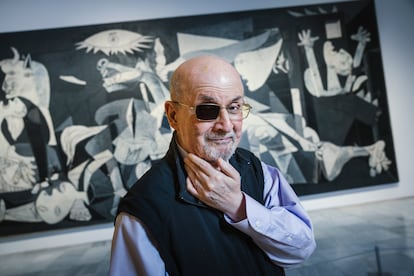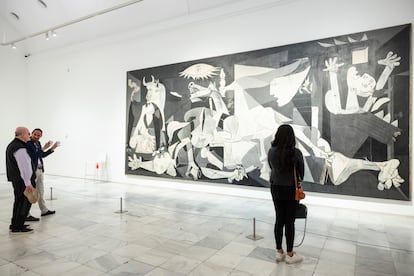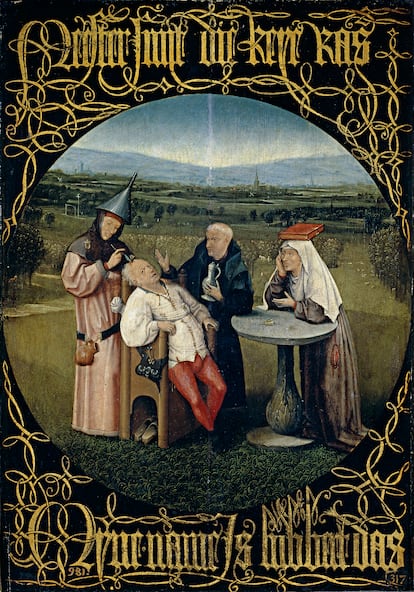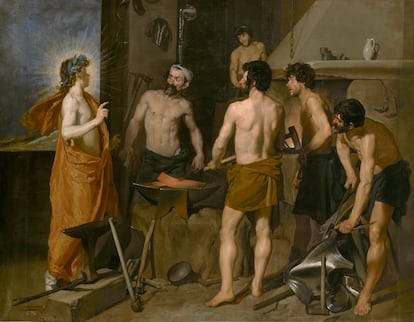Salman Rushdie: ‘The ‘Guernica’ speaks of our time, the bombs are still falling’
EL PAÍS went on a stroll through Madrid’s Prado and Reina Sofía museums in the company of the author, who is visiting Spain to present ‘Knife’, his account of the attack he suffered in 2022

The first painting that the writer Salman Rushdie and his wife, the poet and photographer Rachel Eliza Griffiths, stop in front of at the Prado Museum is curiously appropriate. It is The contemporary poets, by Antonio María Esquivel, which shows a reading of Zorrilla’s work in the painter’s studio. The couple has been making their way through the rooms of the museum to reach Goya’s Black Paintings, and this choral portrait of the men of letters of Spanish Romanticism has caught their attention along the way.
Sir Salman Rushdie, 77, author of 22 books, winner of the Booker Prize in 1981 for Midnight’s Children, member of the group of brilliant bad boys of British literature who took the bookstores by storm, was marked by the fatwa that the Iranian leader Ayatollah Khomeini decreed against him in 1989, and which more than 30 years later led a young Islamic radical from New Jersey to stab him 15 times in just 27 seconds in August 2022. Miraculously, he has lived to tell the tale, and his time in Madrid is part of the promotional tour for Knife, the book in which he narrates the brutal attack and what came after.
Goya, Velázquez and the room with artwork by Hieronymus Bosch is what the writer intends to see this Sunday at the Prado after making his way out of the hotel first thing in the morning on foot. Later, at the Reina Sofía, he will admire Picasso’s painting Guernica. Eight bodyguards accompany his movements, and the hotel has installed a metal detector, but none of this has clouded the good mood of the author, who is dressed in black pants, a pale lilac shirt, a vest, sneakers and a cap. The right lens of his glasses is opaque: it hides the eye that was irreversibly damaged by a stab wound. Discreet and attentive, Griffiths, who married Rushdie in 2021, is dressed in black and carries a camera.
In the room with the two imposing scenes by Goya depicting Spain’s War of Independence, The Charge of the Mamelukes and The Third of May 1808, the visit begins and silence falls. The couple gaze upon the sabers and wounds in the violent representation of the uprising of May 2, 1808, in Madrid against Napoleon’s occupation, and the terrified look of the man who is going to be shot on May 3. In his new memoir, Rushdie describes his own paralysis as the young attacker ran towards him to stab him. He explains how he maintained an almost mortal intimacy with his attacker, and faced in an extreme way the worst and the best of humanity, thanks to those who reacted to save him. Rushdie is determined to move forward, as always.

“The room with Goya’s Black Paintings may be the best in the world, but I’m not sure I would want those paintings in my house,” says Rushdie upon arriving at that gallery. Goya painted the walls of his Quinta del Sordo home at the end of his life; at that point he was deaf and had lived through a war. “Yes indeed, that’s why it wouldn’t be bad to have something to lift your spirits a little. These are impressive, but to have in your living room perhaps a little too much.” Rushdie remembers his last visit to the museum in 2012 and a trip in the 1990s with Mario Vargas Llosa to El Escorial outside Madrid.
In front of the Goya paintings, Rushdie and Griffiths listen attentively while Francisco Tardío, Head of Projection and International Programming, talks to them about how the paintings came to be here. “In all the museums I visit I like to play the game of thinking which painting I would take home. From the Prado I would take that Goya dog. I think Eliza would too. The animal is sweet, and without it the painting is a Turner or a Rothko,” he explains when he has finished the tour. “I was at the Prado for the first time when I was 20 when I was studying at Cambridge, and I traveled to Spain with three friends. We took trains and slept in boarding houses. I was in Toledo, Granada and Málaga.” His connection with Spain was captured in some of his books, such as The Moor’s Last Sigh and Quichotte, but he will talk about that later, back at the hotel.
Standing before Las meninas he marvels at the games played by Diego Velázquez on the canvas. “It’s so sophisticated and advanced. We don’t know what he is painting, and as viewers he places us in the same spot where the kings are,” he says. “It is difficult to detach yourself from this painting.” When he sees Apollo in the Forge of Vulcan, he knows that in that scene Apollo is telling the god of fire that his wife is unfaithful to him. “A gossip scene,” he sums up accurately. He stops before the head of Goliath cut off by David and painted by Caravaggio, but there is no smile or comment here. Cutting the Stone, by Hieronymus Bosch, is a painting that the novelist did not remember and which this morning takes on another meaning. “I love the idea of madness being a stone,” says Rushdie upon seeing it. Later he confesses that this painting on wood has sparked something: “I thought about what I could do with it. If you find anything from me on this topic later, I can tell you that it all started this morning.”

Has the way he looks at the world changed after the 2022 attack? “What happens in the world is what changes the way I look at it. Today we are going through terrible times,” he responds. “My way of thinking is no longer the way people think. The things that worry people change, but if you are in the business of creating art you will always do so and hope that some of your work will last.” In Knife he writes about the night before the stabbing and says that he would like to be able to warn that man of what awaited him. “When I remembered what happened the day before, I thought just that. I have wanted to make a self-portrait, and I feel like it is me. Showing myself to the reader is a way to destroy those other selves that the radical Islamists who have wanted to demonize me have built, and also a way to dismantle the gossip.”
He was 41 years old and had published five books when he was sentenced to death. Today he is 77 and has 22 titles to his name. The attack has not defeated him. “You get to a point where you do what you have to do, as an artist you know the journey you have taken and you know the path you have decided to follow. You leave the rest aside.”
Rushdie’s daring on a literary level, beyond his own biography, has led him to reimagine the character of Don Quixote, placing him in the United States, or to write his own version of the Arabian Nights, called Two Years Eight Months and Twenty-Eight Nights. “Every good writer should feel free. I move on a large canvas. Alice Munro, who recently passed away, was a tremendous writer who wrote about a very limited place on a small canvas. Like Faulkner. Sometimes I am envious of such a deep connection with a place,” he confesses. “My life has been more disruptive and is defined by migration. I belong to cities, to places where many things happen at the same time, where there is multiplicity.” Bombay, London and New York have been his homes.
Affable, calm and good-humored, Rushdie talks about how in the Prado there are not only “magnificent works of art,” but how it is possible to see the conversation that some artists had with each other. “That’s very interesting, seeing who and how they influence each other. Writing is also a conversation with other writers, with what you have read,” he later reflects over a plate of Iberian ham before continuing his visit to Madrid and finishing the day at the U.S. Embassy. On Monday he was scheduled to participate in a talk with the writer Javier Cercas. “Cervantes is very important for any novelist, he is the father of the modern, playful and postmodern novel, especially the second part of Don Quixote, where the characters know that they have appeared in a book and they give their opinion about it. And it is a very, very fun book.” He feels “very grateful” to have a sense of humor, one of his best weapons and something that brought him closer to his friends and generational colleagues Martin Amis and Christopher Hitchens.
The most comical and unpredictable scene of the morning occurs inside the church and convent of the Trinitarian nuns, known as the Monastery of San Ildefonso and San Juan de la Mata. In search of the remains of Miguel de Cervantes, Rushdie and Griffiths are at the back of the temple in front of the tombstone dedicated to the writer when the priest passes by and sprinkles them with holy water too. They have been blessed before Cervantes. “Time is short, desires grow, hopes diminish, and, with all this, I lead life based on the desire I have to live,” is the quote from The Works of Persiles and Sigismunda that is inscribed in the church in homage to the author of Don Quixote, and those words perfectly define the vitalist impulse that moves Rushdie.

Disputes between writers
“The big one, I want to see the big one and the photos of Dora Maar,” the novelist says with some amusement upon arriving at the Reina Sofía Museum, where he is received by the president of the board of trustees, Ángeles González Sinde. In the rooms prior to the encounter with Picasso’s legendary work, the Guernica, the guide talks about the political atmosphere of the conflict, the magazines, posters and photographs that make up the iconography of that time. The explanations continue in front of the canvas.
Rushdie first saw the Guernica at the MoMA in New York, then at the Casón del Buen Retiro in Madrid and also in this same museum a decade ago. “It is a colossal work, the scale is imposing. The light bulb and the horse are already part of our imagination,” he points out. “Guernica speaks of our time and will never go out of style because there are always wars. The bombs keep falling and there are screams.” The Gaza conflict that pits Israel against Hamas today has sparked an entire global protest movement. What does he think? “There are two aspects. On the one hand, civilian deaths are what motivated the protests and, on the other, what to do to resolve this. The divisions that appear to be emerging in Israel may point to what comes next. That dialogue is important. I am not a fan of Hamas for obvious reasons,” he explains.
PEN, the writers’ organization that he presided over and at one of whose events he met his fifth wife, has canceled this year’s festival in New York and the presentation of its awards. “It seems strange to me that they are pointing to PEN and absurd that it is said to support genocide. PEN tries to rescue and help Palestinian writers and writers from other parts of the world. Will ending this organization help stop the war? I don’t believe it.” Political disputes between writers are not something entirely new for Rushdie: he compares his colleagues to a group of cats that go in all directions and are impossible to herd. “Then there are times when everyone is on the same team, it’s cyclical.” Does he consider himself an optimist? “Yes, of course, in order to write one needs to be hopeful.” In Knife he maintains that we would not be who we are today without the calamities of our yesterdays. And Rushdie, there is no doubt, is looking ahead.
Sign up for our weekly newsletter to get more English-language news coverage from EL PAÍS USA Edition
Tu suscripción se está usando en otro dispositivo
¿Quieres añadir otro usuario a tu suscripción?
Si continúas leyendo en este dispositivo, no se podrá leer en el otro.
FlechaTu suscripción se está usando en otro dispositivo y solo puedes acceder a EL PAÍS desde un dispositivo a la vez.
Si quieres compartir tu cuenta, cambia tu suscripción a la modalidad Premium, así podrás añadir otro usuario. Cada uno accederá con su propia cuenta de email, lo que os permitirá personalizar vuestra experiencia en EL PAÍS.
¿Tienes una suscripción de empresa? Accede aquí para contratar más cuentas.
En el caso de no saber quién está usando tu cuenta, te recomendamos cambiar tu contraseña aquí.
Si decides continuar compartiendo tu cuenta, este mensaje se mostrará en tu dispositivo y en el de la otra persona que está usando tu cuenta de forma indefinida, afectando a tu experiencia de lectura. Puedes consultar aquí los términos y condiciones de la suscripción digital.
More information
Archived In
Últimas noticias
There is as much life left to discover on planet Earth as that which is already known
Dozens presumed dead, around 100 injured in fire at Swiss Alps bar during New Year’s celebration
Is porn for women different from conventional porn? We spoke to those who make it
Cartagena de Indias is sinking: What can the city do to mitigate it?
Most viewed
- Sinaloa Cartel war is taking its toll on Los Chapitos
- Reinhard Genzel, Nobel laureate in physics: ‘One-minute videos will never give you the truth’
- David King, chemist: ‘There are scientists studying how to cool the planet; nobody should stop these experiments from happening’
- Oona Chaplin: ‘I told James Cameron that I was living in a treehouse and starting a permaculture project with a friend’
- The Interoceanic Train, the Mexican alternative to the Panama Canal











































